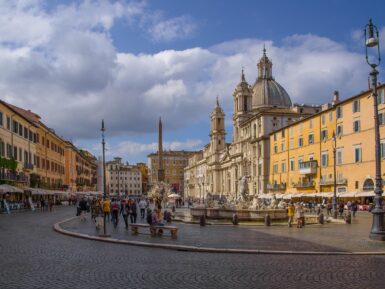Table of Contents
1. History
Campo De Fiori which means “Fields of Flowers”, was originally a meadow on medieval Rome. Unlike many of Rome’s grand squares, it was never designed as a formal Piazza (market) but evolved naturally into an important public space over the centuries.
In the 15th century, Pope Callixtus III paved Compo de’ Fiori, transforming it into a marketplace. By 16th century, it became a center for trade, politics, and social gathering, with landmarks like Palazzo Della Cancelleria.
The square also served as a public execution site most probably for Giordano Bruno, burned at the stake in 1600 for his ideas. His statues now stands in the square, symbolizing free thought.
By the 19th and 20th centuries, campo de’ Fiori became a vibrant market by day and a lively nightlife hub by night, filled with shops, restaurants and street performers.
2. Architecture and Engineering
Unlike many of Rome’s squares, Campo De’ Fiori has no grand churches, fountains, or palaces, making it architecturally unique. Unlike Piazza Navona or Piazza Venezia, which were carefully planned and designed by renowned architects, Campo de Fiori evolved organically over centuries.
It’s layout is simple and functional, reflecting its historical role as a marketplace and gathering space rather than a ceremonial or religious site.
Campo De Fiori is unique for its cobblestone pavements, made of traditional Roman sampietrini, which add to its historic charm. The 15th and 16th-century buildings around the square feature earth-tone facades, wooden shutters, and iron-railed balconies. They are now home to restaurants, bars, and shops. At its center stands the statue of Giordano Bruno, a tribute to the philosophers executed here in 1600.
Unlike Rome’s grand piazzas it has no churches or monumental palaces, keeping its open, lively atmosphere. By day, its a bustling market, and by night a vibrant social hub, offering an authentic Roman experience.
3. Best things to do in Campo De’ Fiori

1. Explore the Famous Market – Visit the lively morning market for fresh produce, spices, pasta, flowers and local delicacies.
2. See the Statue of Giordano Bruno – Learn about the philosopher’s tragic history and admire the 1889 bronze statue at the center of the squares.
3. Enjoy the local cuisine – Dine at traditional Roman trattorias and try classics like carbonara, Cacio e pepe, and pizza bianca. You can go to famous places to eat like Giordi, Romoletto and many more. These two are my personal favorites.

4. Sip Italian Wine & Cocktails – Experience Campo De’ Fiori’s bustling nightlife with a glass of wine or a aperitivo at a local bar.
5. Shop for Souvenirs – Pick up Italian olive oil, balsamic vinegar, truffle products and handcrafted goods from market stalls and shops.
6. Admire historic architecture – Take in the 15th and 16th century buildings, with their earth-toned facades, wooden shutters and iron balconies.

7. Visit Nearby Landmarks—Walk to Piazza Navona, the Pantheon, or the Jewish ghetto, all just a short distance away.

8. Experience the Nightlife – After dark, the square turn into one of Rome’s most popular nightlife spots, with bars music and street performances.
9. People -Watch from a cafe – Grab a coffee or gelato and soak in the vibrant atmosphere of locals, tourists and street artists.
10. Join a Food or Walking Tour – Discover the area’s history and flavors with a guided market or street food tour. looking for more things to do in Rome Check out our guide on 25 things to do in Rome
4. Photography Tips for Campo De’ Fiori
1.Capture the market colors – Shoot the fruit, vegetables, and flowers stalls in the morning for vibrant colors and soft natural light.
2. Frame Giordano Bruno – Take a low-angle shot of the statue against the sky for a dramatic effect, especially at sunset.
3. Highlight Historic Architecture – Focus on the earth-toned facades, wooden shutters and iron balconies for a timeless Roman feel.
4. Show Day-to-Night Contrast – capture the bustling market by day and return at night for the glowing lights and lively atmosphere.
5. Use Reflections After Rain – Wet cobblestones reflect lights and colors creating a stunning and moody composition.
5. Best Time to Visit
The best time to visit Campo De’ Fiori depends on the experience you are looking for. Morning (07:00 AM – 11:00 AM) are perfect for exploring the lively market, capturing its vibrant colors and enjoying a quieter atmosphere. For a more energetic vibe, evenings (06:00 PM – late night) offers a bustling nightlife scene with lively bars and outdoor dinning.
The ideal months to visit are April to June and September to October when the weather is pleasant and the crowds are manageable.
6. FAQ’s
1 Why is Campo di Fiori famous?
Campo De’ Fiori is famous for its historic open air market, bustling nightlife and the statue of Giordano Bruno, making the site of his execution in 1600.
2. What days is the Campo de Fiori market on?
The market runs from Monday to Saturday from 07:00 AM to 02:00 PM. Its closed on Sunday’s.
3. Is Campo di Fiori worth visiting?
Yes, it is worth visiting for its vibrant market, local atmosphere, historic charm and lively bars, offering an authentic Roman experience.
4. What is the best time to go to Campo de Fiori?
Visit the morning (07:00 AM – 11:00 AM)for the market or evening (06:00 PM – late night) for the night-life. The best months are April-June and September-October.
5. What are the opening hours of Campo de Fiori market ?
The market operates Monday to Saturday 7am to 2pm.





Leave a reply